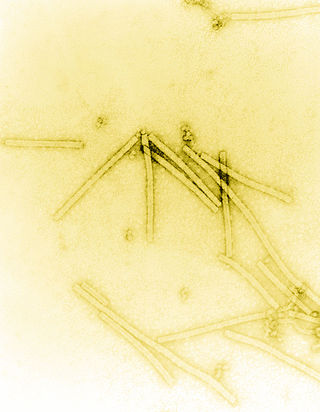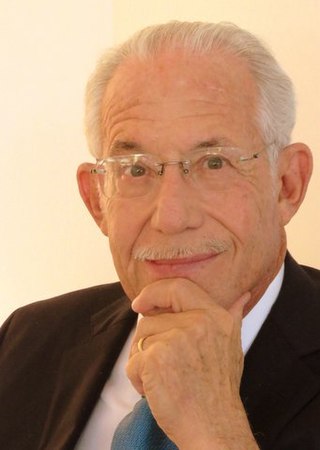
The human immunodeficiency viruses (HIV) are two species of Lentivirus that infect humans. Over time, they cause acquired immunodeficiency syndrome (AIDS), a condition in which progressive failure of the immune system allows life-threatening opportunistic infections and cancers to thrive. Without treatment, average survival time after infection with HIV is estimated to be 9 to 11 years, depending on the HIV subtype.
Various fringe theories have arisen to speculate about purported alternative origins for the human immunodeficiency virus (HIV) and the acquired immunodeficiency syndrome (AIDS), with claims ranging from it being due to accidental exposure to supposedly purposeful acts. Several inquiries and investigations have been carried out as a result, and each of these theories has consequently been determined to be based on unfounded and/or false information. HIV has been shown to have evolved from or be closely related to the simian immunodeficiency virus (SIV) in West Central Africa sometime in the early 20th century. HIV was discovered in the 1980s by the French scientist Luc Montagnier. Before the 1980s, HIV was an unknown deadly disease.

HIV/AIDS denialism is the belief, despite conclusive evidence to the contrary, that the human immunodeficiency virus (HIV) does not cause acquired immune deficiency syndrome (AIDS). Some of its proponents reject the existence of HIV, while others accept that HIV exists but argue that it is a harmless passenger virus and not the cause of AIDS. Insofar as they acknowledge AIDS as a real disease, they attribute it to some combination of sexual behavior, recreational drugs, malnutrition, poor sanitation, haemophilia, or the effects of the medications used to treat HIV infection (antiretrovirals).
The year 1983 in science and technology involved many significant events, as listed below.

The Pasteur Institute is a French non-profit private foundation dedicated to the study of biology, micro-organisms, diseases, and vaccines. It is named after Louis Pasteur, who invented pasteurization and vaccines for anthrax and rabies. The institute was founded on 4 June 1887, and inaugurated on 14 November 1888.

AIDS is caused by a human immunodeficiency virus (HIV), which originated in non-human primates in Central and West Africa. While various sub-groups of the virus acquired human infectivity at different times, the present pandemic had its origins in the emergence of one specific strain – HIV-1 subgroup M – in Léopoldville in the Belgian Congo in the 1920s.
Donald Pinkston Francis is an American epidemiologist who worked on the Ebola outbreak in Africa in the late 1970s, and as an HIV/AIDS researcher. He retired from the U.S. Public Health Service in 1992, after 21 years of service. He lives in San Francisco, California.

Robert Charles Gallo is an American biomedical researcher. He is best known for his role in establishing the human immunodeficiency virus (HIV) as the infectious agent responsible for acquired immune deficiency syndrome (AIDS) and in the development of the HIV blood test, and he has been a major contributor to subsequent HIV research.

The history of virology – the scientific study of viruses and the infections they cause – began in the closing years of the 19th century. Although Edward Jenner and Louis Pasteur developed the first vaccines to protect against viral infections, they did not know that viruses existed. The first evidence of the existence of viruses came from experiments with filters that had pores small enough to retain bacteria. In 1892, Dmitri Ivanovsky used one of these filters to show that sap from a diseased tobacco plant remained infectious to healthy tobacco plants despite having been filtered. Martinus Beijerinck called the filtered, infectious substance a "virus" and this discovery is considered to be the beginning of virology.

Françoise Barré-Sinoussi is a French virologist and Director of the Regulation of Retroviral Infections Division and Professor at the Institut Pasteur in Paris, France. Born in Paris, France, Barré-Sinoussi performed some of the fundamental work in the identification of the human immunodeficiency virus (HIV) as the cause of AIDS. In 2008, Barré-Sinoussi was awarded the Nobel Prize in Physiology or Medicine, together with her former mentor, Luc Montagnier, for their discovery of HIV. She mandatorily retired from active research on August 31, 2015, and fully retired by some time in 2017.
Jean-Claude Chermann is a French virologist who managed the research team which, by 1983, under the administrative supervision of Luc Montagnier, had discovered the virus associated with AIDS. Whereas second author of this initial publication and obviously involved as team manager in this discovery, he had been omitted from the Nobel Prize attributed to its colleagues. In 2008, as chairman of the support committee for the attribution of the Nobel Prize in medicine to Jean-Claude Chermann, Bernard Le Grelle, a political consultant, campaigned for the official recognition of this oversight with the Nobel committee by bringing together more than 700 doctors, professors and scientists . The virus was named lymphadenopathy-associated virus, or LAV. A year later, a team led by Robert Gallo of the United States confirmed the discovery of the virus, but renamed it human T-lymphotropic virus type III (HTLV-III).

Willy Rozenbaum is a Polish-born French physician.

Continuum was a magazine published by an activist group of the same name who denied the existence of HIV/AIDS.

William A. Haseltine is an American scientist, businessman, author, and philanthropist. He is known for his groundbreaking work on HIV/AIDS and the human genome.

Jacques Leibowitch was a French medical doctor and clinical researcher known for his contributions to the knowledge and treatment of HIV and AIDS, starting with his initial designation of a human retrovirus as the cause of AIDS, and his ground-breaking use of triple combination therapy for the effective control of HIV in the patient. A practicing physician in the infectiology department of the Raymond Poincaré University Hospital of Garches, University lecturer Emeritus, he led the treatment program ICCARRE that proposes a dramatic reduction of weekly anti-HIV drug intake, down to 2-3 anti-viral pills a day taken 2 to 3 or 4 days a week, as opposed to the presently recommended seven days a week, as still universally prescribed. These reduced medical dosages are adequate, necessary and sufficient according to the results of his exploratory clinical research carried out since 2003. He is the author of the books "Un virus étrange venu d'ailleurs", and "Pour en finir avec le sida".
DNA teleportation is a pseudoscientific claim which suggests that DNA can produce electromagnetic signals (EMS) that are measurable when highly diluted in water. The claim suggests these signals can allegedly be recorded, transmitted electronically and re-emitted on another distant pure water sample, where the DNA can replicate through polymerase chain reaction, despite the absence of the original DNA in the new water sample. The idea was introduced by the Nobel laureate Luc Montagnier in 2009. It is similar in principle to water memory, a similar pseudoscientific claim popularised by Jacques Benveniste in 1988.
Pierre Charneau is a French virologist, inventor, and head of the Molecular Virology and Vaccinology Unit (VMV) at the Pasteur Institute and an acknowledged specialist in HIV, lentiviral gene transfer vectors, and their medical applications. His discovery of the central DNA-flap structure in the HIV genome, and its role in viral entry into the nucleus of the infected cell, grounded the optimization of lentiviral vectors and allowed for more than 20 years of development in gene therapy and vaccines based on this gene delivery technology. Charneau has published more than 100 research articles and holds 25 patents in the field of HIV and lentiviral vectors.
Mads Melbye is director of the Cancer Institute in Denmark (DCRC). He earned his M.D. degree from University of Aarhus, Denmark, in 1983, and a DMSc degree from the same university in 1988. His thesis work was partly done as a fellow in the epidemiology program 1985-1986 at the National Cancer Institute, NIH, US. After clinical training he became senior investigator in 1989 at the Danish Cancer Registry in Copenhagen, and in 1991 state epidemiologist at Statens Serum Institut (SSI) in Copenhagen. In 1992, Melbye was given a personal chair in infectious disease and cancer epidemiology by the Danish minister for research and education. He founded the Department of Epidemiology Research at SSI and to day this department is one of Europe's largest epidemiology research milieus. From 1998 to 2008 he was foreign adjunct professor at Medical Epidemiology and Biostatistics Branch at Karolinska University in Stockholm. In 2012 he established the Danish National Biobank which is one of the biggest biobanks in the world today. Same year he became senior vice-president at Statens Serum Institut in Copenhagen and from 2016 till 2020 president and CEO. He is presently professor of medical epidemiology at University of Copenhagen and affiliated with Department of Genetics at Stanford University School of Medicine.
Nobel disease or Nobelitis is the embracing of strange or scientifically unsound ideas by some Nobel Prize winners, usually later in life. It has been argued that the effect results, in part, from a tendency for Nobel winners to feel empowered by the award to speak on topics outside their specific area of expertise, although it is unknown whether Nobel Prize winners are more prone to this tendency than other individuals. Paul Nurse, co-winner of the 2001 Nobel Prize in Physiology or Medicine, warned later laureates against "believing you are expert in almost everything, and being prepared to express opinions about most issues with great confidence, sheltering behind the authority that the Nobel Prize can give you". Nobel disease has been described as a tongue-in-cheek term.

Maria Odette Santos Ferreira was a Portuguese professor of microbiology who played an important role in research on HIV, through the identification of the HIV-2 virus in association with the Pasteur Institute of Paris. She was also the coordinator of the Portuguese programme to fight AIDS, overseeing the "Say no to a second-hand syringe" project, which resulted in the collection and exchange by pharmacies of 43 million used syringes between 1993 and 2008.












